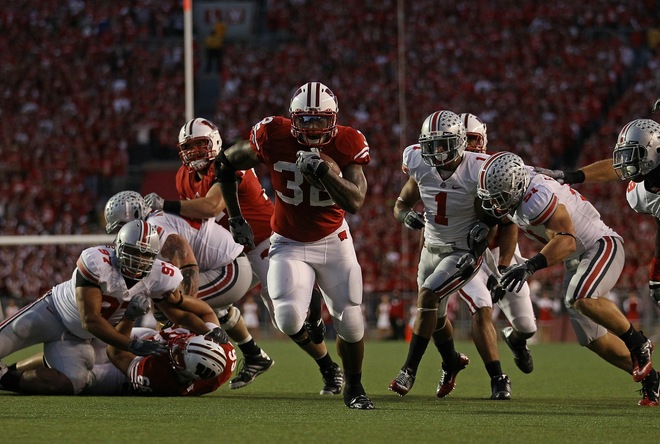I have never understood why players don’t lateral the ball out of bounds to stop the clock in pro or college football in the USA. If time is running out and the player is tackled in bounds the clock keeps running and time can expire. You can stop the clock by running out of bounds. Also if the ball goes out of bounds the clock is stopped. I figured maybe there was some rule against just throwing the ball out of bounds to stop the clock. I never hear announcers explain that they can’t just throw the ball out of bounds due to a rule, though.

I decided to go the the source, on page 73 of the official NCAA football rules it says the clock stops: “With fewer than two minutes remaining in a half a Team A ball carrier, fumble or backward pass is ruled out of bounds.”
However, on page 103 (of 272) it states: “A ball carrier may hand or pass the ball backward at any time, except to throw the ball intentionally out of bounds to conserve time. [The penalty for breaking the rule is] five yards from the spot of the foul; also loss of down.” The clock is started when the ball is ready for play (rule 3-4-3 says the clock restarts on the ready to play signal for “unfair clock tactics” penalties).
From the rule book appendix: “A ball carrier, late in the second period, throws a backward pass out of bounds from behind or beyond the neutral zone to conserve time. RULING: Penalty – Five yards from the spot of the foul and loss of down. The clock starts on the ready-for-play signal.” By the way an illegal forward pass has the same penalty.
Still to me this leaves a very good reason to lateral the ball out of bounds. It should certainly take less time to line up and ground the ball after the ball is marked ready for play than it would if the clock is never stopped. Often you could still have time to run a play or just ground the ball and stop the clock.
The NFL does use a 10-second runoff rule, and with the referee winding the clock on the ready for play, which would likely make an deliberate attempt a bad idea. But as far as I can tell college rules don’t have that time penalty. It seems to me, if you want to have a rule against stopping the clock that way, it probably is wise to have the 10 second penalty.
Even if for some reason taking that penalty doesn’t work if you are in the middle of the filed you could thrown it to someone near the sidelines to let them get out of bounds. Also if you at least make that attempt and then the ball goes out of bounds (based on your lateral attempt) it seems to me you at least have the hope the referees won’t call the penalty that requires your intent to thrown it out of bounds to stop the clock, in order for it to be a penalty.
Related: Randomization in Sports – NHL Experiments with the Rules of Hockey – Physicist Swimming Revolution
I think I can slip this into a management context by seeing it as creativity, innovation, continual improvement or problem solving – maybe?
In sports, rules evolve. I believe there was a rule change in the last 10 years that made it acceptable for a quarterback to just throw the ball into the ground immediately to stop the clock.


Is this rule applicable at the high school level as well? I call at both high school and collegiate levels. This is very clear in the NCAA rule book but not clear in either the nfhs rule or case books.
Pingback: Taking Risks Based on Evidence » Curious Cat Management Improvement Blog
I have wondered about this exact same question for years. Thanks for doing the research and publishing the article. Also it lead me to check out your site. I am also an advocate of lean and the teachings of Deming. I look forward to reading more of your articles!
How about this, throw ball down middle of field which is usually wide open in those situations and then reciever throws a lateral to sideline to a presumably open teammate